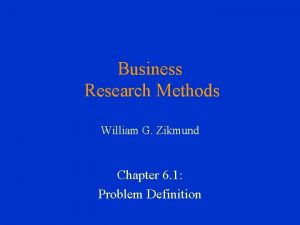Essentials of Marketing Research William G Zikmund Chapter

































- Slides: 33

Essentials of Marketing Research William G. Zikmund Chapter 14: Basic Data Analysis

Tabulation • Frequency table • Percentages

Type of Scale Measure of Central Tendency Measure of Dispersion Nominal Ordinal Interval or ratio Mode Median Mean None Percentile Standard deviation

CROSS-TABULATION • • Analyze data by groups or categories Compare differences Contingency table Percentage cross-tabulations

ELABORATION AND REFINEMENT • Moderator variable • Spurious relationship

Data Transformation • A. K. A data conversion • Changing the original form of the data to a new format • More appropriate data analysis • New variables

CALCULATING RANK ORDER • Ordinal data • Brand preferences

TABLES • Bannerheads for columns • Studheads for rows

Charts and Graphs • Pie charts • Line graphs • Bar charts – Vertical – Horizontal

Line Graph

Bar Graph

Web. Surveyor Bar Chart

Computer Programs • • • SPSS SAS SYSTAT Microsoft Excel Web. Surveyor

Hypothesis • An unproven proposition or supposition that tentatively explains certain facts of phenomena • Null hypothesis • Alternative hypothesis

Significance Level • Critical probability in choosing between the null hypothesis and the alternative hypothesis • Probability level selected is typically. 05 or. 01 • Too low to warrant support for the null hypothesis

Testing A Hypothesis About A Mean

The null hypothesis that the mean is equal to 3. 0:

The alternative hypothesis that the mean does not equal to 3. 0:

A Sampling Distribution m=3. 0

A Sampling Distribution a=. 025 m=3. 0

A Sampling Distribution UPPER LIMIT LOWER LIMIT m=3. 0

Critical values of m Critical value - upper limit

Critical values of m

Critical values of m Critical value - lower limit

Critical values of m

Region of Rejection LOWER LIMIT m=3. 0 UPPER LIMIT

Hypothesis Test m =3. 0 2. 804 m=3. 0 3. 196 3. 78

Type I and Type II Errors in Hypothesis Testing State of Null Hypothesis in the Population Decision Accept Ho Reject Ho Ho is true Ho is false Correct--no error Type II error Type I error Correct--no error

Testing a Hypothesis about a Distribution • Chi-square test • Test for significance in the analysis of frequency distributions • Compare observed frequencies with expected frequencies • “Goodness of fit”

Chi-Square Test

Type of Measurement Type of descriptive analysis Two categories Nominal More than two categories Frequency table Proportion (percentage) Frequency table Category proportions (percentages) Mode

Type of Measurement Type of descriptive analysis Ordinal Rank order Median

Type of Measurement Type of descriptive analysis Interval Arithmetic mean
 Business research methods william g. zikmund
Business research methods william g. zikmund Exploring marketing research zikmund
Exploring marketing research zikmund Exploring marketing research
Exploring marketing research William g. zikmund
William g. zikmund Business research methods by zikmund
Business research methods by zikmund Zikmund business research methods
Zikmund business research methods Stapel scale
Stapel scale Zikmund lucemburský
Zikmund lucemburský Marketing essentials chapter 38
Marketing essentials chapter 38 Merchandise approach method
Merchandise approach method Form utilities
Form utilities Essentials of social media marketing chapter 9 quiz
Essentials of social media marketing chapter 9 quiz Marketing essentials chapter 2
Marketing essentials chapter 2 Network security essentials 5th edition pdf
Network security essentials 5th edition pdf Network security essentials william stallings ppt
Network security essentials william stallings ppt Essentials of health care marketing
Essentials of health care marketing Marketing essentials meaning
Marketing essentials meaning Marketing information systems and marketing research
Marketing information systems and marketing research Marketing information systems and marketing research
Marketing information systems and marketing research Marketing information system and marketing research
Marketing information system and marketing research Marketing information systems and marketing research
Marketing information systems and marketing research Marketing information systems and marketing research
Marketing information systems and marketing research Marketing information systems and marketing research
Marketing information systems and marketing research Management decision problem and marketing research problem
Management decision problem and marketing research problem It essentials chapter 8
It essentials chapter 8 What are the ten essentials of a successful ffa chapter
What are the ten essentials of a successful ffa chapter It essentials chapter 9
It essentials chapter 9 It essentials
It essentials It essentials chapter 12 quiz
It essentials chapter 12 quiz It essentials chapter 11
It essentials chapter 11 Business essentials 12th edition
Business essentials 12th edition It essential chapter 5
It essential chapter 5 It essentials chapter 3
It essentials chapter 3 It essentials chapter 11
It essentials chapter 11






















































